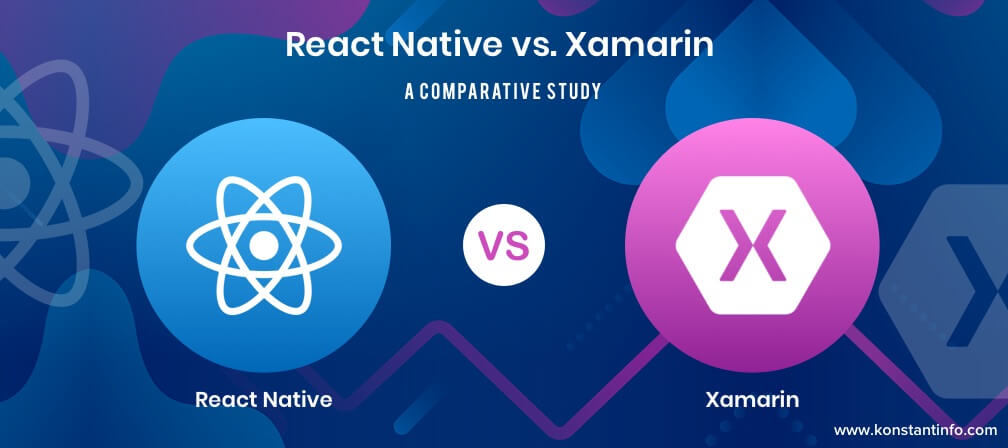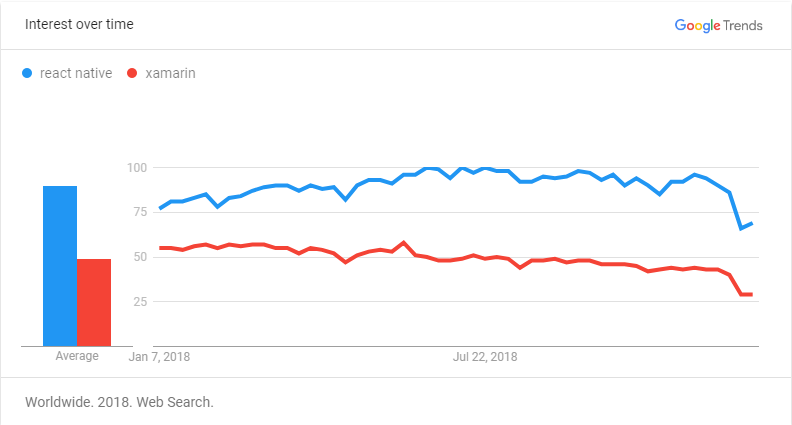
An average of 6,140 mobile apps is released through the Google Play Store every day, but the decision to select the right development approach is becoming increasingly difficult as there is no clear demarcation between native vs. hybrid approaches, as both these approaches commingle cost-effectiveness and performance. While mobile apps are not only required to reduce costs and device a new form of conversions, these are as well important in increasing user engagement.
Mobile applications are already contributing a lot to global revenue via app stores and in-advertising with the emergence of small and large businesses. This market is going to reach $188.9 billion USD by the year 2020 according to statista.com. (Enclosed Graph)

Image source: statista.com
Users are loaded with lot many applications on their smartphones and the only features they are really concerned about is app performance, usability, navigability, UX/UI and how well it integrates with the mobile OS. React Native comes at a rescue in such a situation. It is the framework that helps create native mobile apps with help of JavaScript. Normal mobile apps are usually programmed using Java (for Android) and Swift/Objective-C (for iOS), but React Native removes this requirement and leads to a completely functional app that can be used on both platforms in much less time and by making use of just one coding language.
Read also: Most Popular Hybrid App Development Frameworks

Are you looking for Hybrid app development partner for your project?
Hire Konstantinfo: India’s trusted Xamarin and React Native app development company
Every framework has its own set of pros and cons, therefore, the developers must decide which tools to choose. The cross-platform mobile development follows a classic native approach – One written in Swift or Objective-C for iOS and Java for Android. As the same code has to be written two times for both the platforms, therefore this approach is slightly time-consuming and also turns out to be expensive. With highest code consistency, Xamarin allows engineers to write the code once and apply some parts of it across all platforms. Although this practice might be cost-effective most of the times this happens on the cost of application performance and behavior. Xamarin Developer India has been applying new approaches and tools to mitigate these disadvantages. Although, Xamarin is a widely used cross-platform development solution for mobile, tablet and desktop applications, but React Native outperforms these disadvantages.
These are not only effective on cost, saves time and can also give developers the flexibility to mix and match best things of various technologies and develop robust applications.
Also read: React Native vs. Ionic: The Bulls Are On A Roll!
As the discussion lengthens, it must be noted that one should not select a development approach because of the technology but must choose it because of its functionality. What if the application is not able to consume all the device features? Then you will have to waste a lot of time and money by adding these features manually. Consider this differentiation:
Attributes | Xamarin | React Native | |
|---|---|---|---|
| Language of Development | C# | JavaScript | |
| Framework | Xamarin works in It works in the MVVM framework style. If you work on ASP.NET MVC, Web Forms this platform is preferred. | This is preferable only if React Native developers are happy with recent developments in JavaScript. | |
| Compilation | iOS | AOT | Interpreter |
| Android | JIT/AOT | JIT | |
| Portability | iOS, Android, Windows, MAC OS | iOS, Android | |
| UI Engineering | Code sharing for the cost of the native experience | Customization with built-in UI components | |
| Code Reusability | Xamarin – iOS/Android – Business Logic, Data Access, Network Communication Xamarin.forms – Up to 96 percent of the code | ||
| Stars on GITHUB | 5K | 69.3K | |
| UI Rendering | Native UI Controllers | Native UI Controllers | |
| Development Environment | Xamarin is more powerful, because, it allows writing code for iPhone app on Windows and compile it for Mac. But a different platform is required for the build. | It allows the developers to choose an IDE in which they are comfortable. It comes with hot loading feature which does not require a full application reload after code modification. | |
| Tools | Documentation part can further be improved but the components are split between NuGet and component store. | All the components are in place with excellent documentation. | |
| Community and Assistance | Large | Growing | |
| Price | Open Source/Visual Studio for commercial use $539-2,999 | Open-source | |
| The Language Stack | With Xamarin, as the entire code is written in C#, the Net framework is utilized for all mobile platforms. Codes are written for iOS in Objective C and Swift and Java for Android can be written in C# for Xamarin cross-platform mobile app development. | React Native app development companies make use of JavaScript. It combines the goodness of JavaScript and ReactJS, a web framework that is backed by Facebook. | |
| Benefits | Xamarin binds native open-source libraries that are available for iOS and Android along with many .NET libraries. Xamarin allows a lot of open sources and in-house source code projects that can be reused in Xamarin iOS and Xamarin Android projects with the help of C# and .NET framework. | React Native allows writing modules in Objective C, Swift – for iOS and Java for Android. React Native apps make use of native modules and libraries that enable handling of computationally heavy operations like image editing, video processing or any unconventional operations that are not included in framework API’s. | |
| Performance | Xamarin is a way to develop apps for cross-platform via two approaches Xamarin.Forms and Xamarin.Android/iOS. But the developed application is slow on performance as compared to react native. | React native is rated high on performance as compared to Xamarin as it renders code components directly to the native API’s using the JavaScriptCore virtual machine both for iOS and Android. | |
| Graphical User Interface (GUI) | Xamarin allows creating the user interface in two ways: using Xamarin.Android/iOS or Xamarin.Forms. | React Native modules interact with native iOS and Android UI controllers, which enables user experience close to native apps. It also uses the ReactJS library with extensive UI components, which can streamline the UI development. As a result, React Native has many UI components out-of-the-box like buttons, modules, and sliders that make developer work faster. | |
| Coding, building and debugging | Xamarin requires Visual Studio to develop, build and debug apps. | React Native can make use of Visual Studio, WebStorm, Atom or ALM to debug and deploy apps to the app store. | |
| Latest Version | Android 4.1+, iOS 8+ | Android 4.0.3+, iOS 8+, Windows 10+ | |
| Availability | Enterprise level application is paid, rest are freely available. | This is free for both Android and iOS. | |
Reduced cost, reusable code, faster time-to-market, and native app-like performance are some of the preliminary reasons behind acceptance of cross-platform app development.
The fundamental difference between React Native and Xamarin is for the type of applications that they are used to build. Xamarin makes use of C# and native libraries wrapped in the .NET layer as it is a Microsoft-supported framework for cross-platform mobile app development. Xamarin is efficient enough to be deployed to create multiple mobile apps making use of single code i.e. C#. It helps developers create a comprehensive environment with its powerful IDE where Xamarin Studio and Microsoft Visual Studio can be integrated. Its high compiled code, test suite, options to make use of native UI across various platforms make this platform extensively preferable.
As we investigate further Ionic and React Native are two other popular app development frameworks available for building cross-platform apps. React Native is a cross-platform native app development framework while Ionic is a Hybrid HTML and JavaScript framework.
Also read : Flutter vs. React Native – A Growing Divergence of Opinion
React Native is an open source and free JavaScript framework that uses JavaScript and XML markup (JSX) to develop cross mobile apps that are comparatively similar to native counterparts. Its unique ability to develop native apps for Android and iOS, just like those built with Java, Swift, or Objective-C along with its declarative programming style, virtual DOM concept, and reusable components to speed up mobile app development cycle. Reasons to select react native:
Already have an app in mind? Skip ahead to few of our picks. Would you like a free instant quote? We at Konstant are here for you!



Neeti Kotia is a technology journalist who seeks to analyze the advancements and developments in technology that affect our everyday lives. Her articles primarily focus upon the business, social, cultural, and entertainment side of the technology sector.
Or send us an email at: [email protected]